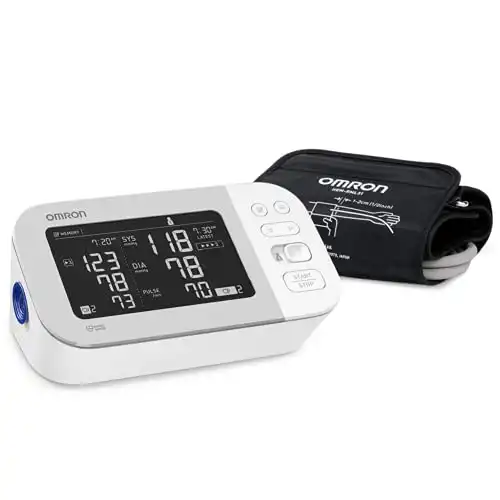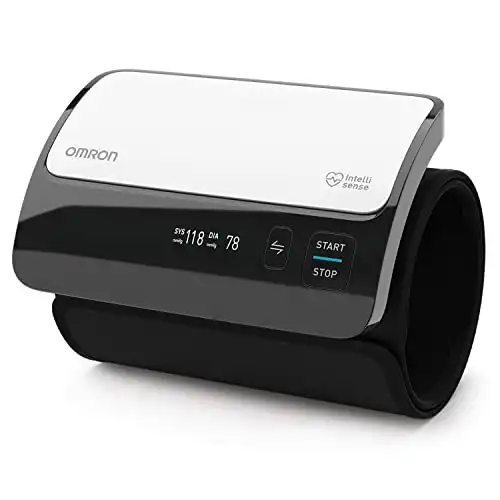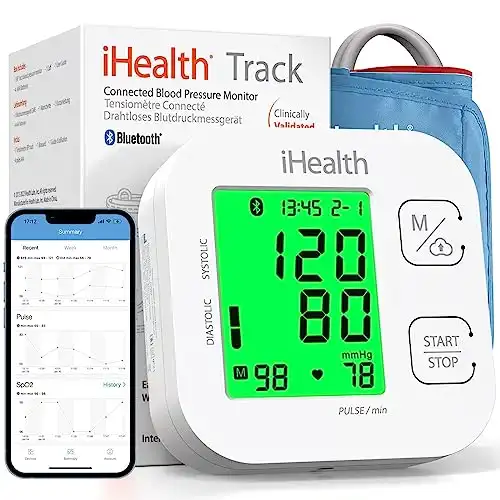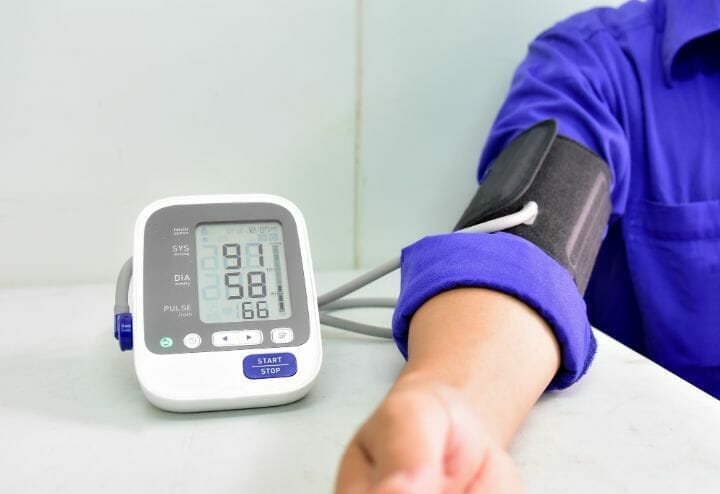This article talks about the key features of the best blood pressure monitor for seniors and suggests the best options across different price ranges. If you are in a hurry, the table below gives a quick snapshot or you can scroll down for detailed reviews.
|
Power Source:
Battery Powered
|
Power Source:
Battery Powered
|
Power Source:
Battery Powered
|
Power Source:
Battery Powered
|
|
Product Dimension:
7.5 x 3.3 x 4.7 inches
|
Product Dimension:
2.36 x 2.16 x 6.10 Inches
|
Product Dimension:
1 x 3.5 x 4.63 inches
|
Product Dimension:
3.9 x 3.9 x 1.6 inches
|
|
Product Weight:
0.46 lbs
|
Product Weight:
0.5 lbs
|
Product Weight:
0.5 lbs
|
Product Weight:
0.97 lbs
|
|
Pros:
|
Pros:
|
Pros:
|
Pros:
|
|
Cons:
|
Cons:
|
Cons:
|
Cons:
|
- Connects to Alexa and smartphone app and has multiple user memories
- Incompatible with all iOS and Android devices and cuff fits up to 17"
- Rechargeable via micro USB that one charge lasts up to 6 months
- Reports to healthcare provider from the app only available on iOS
- Omron App's Bluetooth support helps in noting blood pressure fluctuations
- Other family members can simultaneously track their readings only on their smartphones.
- Color-coded backlit display indicates if your blood pressure is optimal or not.
- No option to average the last three readings
Contents
A good home blood pressure monitor is a must-have piece of healthcare equipment that older adults and caregivers should consider buying, if not done yet.
Blood Pressure measurements and pulse measurements are incredibly useful in terms of assessing and optimizing an elderly’s health and wellbeing. This does not mean that they are not beneficial for those elderly who are not being treated for hypertension-related issues.
How Can a Home Blood Pressure Monitor Be Helpful In a Household?
Checking the blood pressure at home can help the elderly and their families in getting better help from their physicians. This help can be three-fold.
1. Identifying or Monitoring Elderly’s Health Condition
Blood Pressure monitoring can be helpful in identifying the seriousness of the illness or the elderly’s health condition. When a healthcare advice line is contacted, caregivers are in a better situation to help over the phone if they are able to inform the respective doctor or nurse about the blood pressure and pulse of the patient.
Doctors generally worry the most about heart rates that are much higher than usual and blood pressure that is much lower than the usual. If the blood pressure is monitored regularly and maintained in a log, it becomes far easier to identify any trends and differences in pulse and BP as compared to the usual numbers.
2. Help in Reducing the Fall Risk
Checking sitting vs standing blood pressure can help in reducing the fall risk. Many older people tend to experience a drop in their blood pressure while standing up. This is especially seen in those who are taking medication to lower blood pressure.
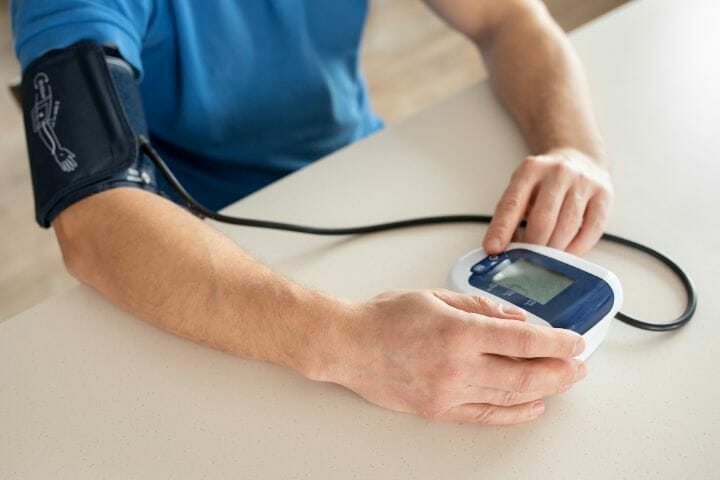
This can mean that an acceptable sitting BP reduces to a level that is potentially fall-inducing right after the person is standing. It is thus essential to check both sitting and standing blood pressure especially in the case of elders who have had falls or near falls in the past.
3. Checking the Effects of Any Recent Medication Changes
Blood Pressure measurements can be used to check the effect of any recent medication changes. Seniors and caregivers are encouraged to check the BP at home for 3-7 days after a change in medication for BP or heart-related ailments as BP can be an important factor in how comfortable an elderly person feels. This can assist the families to become proactive in helping doctors with the apt amount of dosage.
You may also like Best Pillbox with Alarm
Different Kinds of Blood Pressure Monitors
Home blood pressure monitors come either with a wrist cuff or an arm cuff. You may consider their features, pricing, performance, etc. when planning to make a choice.
Arm Monitors
Arm Monitors inflate the cuff automatically and give the readings. Some arm cuff monitors come with risk category indicators that will flag high readings. Some models provide the option to download the blood pressure results to a computer which makes it easier for you to share the readings with your doctor.
- Pros: The biggest pro for arm cuff monitors is that they are more accurate in blood pressure testing. Some models also come with multiple memories that allow BP monitoring of more than one person in the household to monitor and record the blood pressure.
- Cons: In order to get accurate readings, it is essential to have the correct fit of the arm cuff. If the cuff is too loose or tight, you are bound to get inaccurate readings. Additionally, the units are not as comfortable as wrist monitors. They may be bulky and sometimes not portable.
Wrist Monitors
Wrist Monitors although fully automatic, are considerably less accurate than arm monitors.
- Pros: They are portable, lightweight, and compact. They are also usually more comfortable and convenient to operate as compared to arm monitors.
- Cons: Wrist monitors are less accurate. The primary reason behind this is that blood pressure measurements taken at the wrist are very sensitive to the position of the body. For getting an accurate reading, both arm and wrist cuffs should be positioned at the level of your heart. Getting this position is much difficult in the case of a wrist cuff.
You may also like Who Should Wear a Medical Alert Bracelet
Factors to Consider When Buying a Blood Pressure Monitor for Seniors
How Easy Is It to Get Accurate Readings From the Monitor?
Look for an automatic digital monitor unless you are a medical professional who knows how to use manual cuffs correctly. Manual cuffs require more training to use properly. A good quality digital monitor will be convenient, more accurate, and easier to work with overtime.
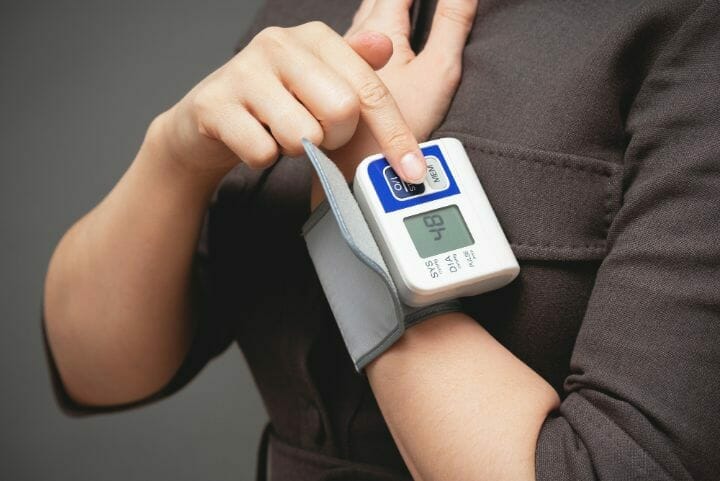
Wrist and finger cuffs sometimes give inaccurate readings if the body position is not right. One should thus prefer to use a monitor with a cuff that measures at the upper arm.
A quick tip to check on the accuracy of your home blood pressure monitor is to carry it to your doctor’s clinic and compare its reading to the clinic monitor. Accurate and reliable readings are key to buying a blood pressure monitor.
Is the Arm Cuff of the Blood Pressure Monitor Sized Properly?
Arm cuffs are usually available in three sizes-small, standard, and large. It is very important to have a cuff that is the right size for the patient’s arm. A cuff that is too small can give falsely high readings while a cuff that is too big can give falsely low readings.
The cuff for an arm monitor should fit the circumference of your arm. You can even use a tape just to be certain. Wrist models generally fit most people.
Is the Process of Logging in Readings Simple Enough to Share With Your Doctor?
A home blood pressure monitor would be a lot more helpful if the process of login readings is easy and the information can be easily shared with the respective doctor or nurse.
The market has all kinds of blood pressure monitors. Some of them can store a certain number of readings even for two different people. These readings can be hard to share and families end up logging in the blood pressure readings by hand.
Others can connect to the home computer for readings to be easily downloaded. A few monitors can also connect to a smartphone using Bluetooth.
Does It Have Relevant Features That You Would Require on a Regular Basis?
There are many features that you should look for when purchasing a blood pressure monitor. Some features to consider would be an irregular-heartbeat detector, a data averaging function, a risk-category indicator, a large digital display, multiple user memories, multiple cuffs, etc.
You may also like Best No Contract Medical Alert System
Things to Keep in Mind When Using a Blood Pressure Monitor at Home
In terms of using a blood pressure monitor, one should keep three things in mind.
1. Proper technique: The upper arm with the BP cuff should be positioned at the same level as the heart. The patient can sit in the chair and rest the arm on a nearby table. The arm should be fairly relaxed. Wrap the cuff around the bare arm. Ensure that there are no clothes between the cuff and the skin. Do not roll up the shirt sleeves as this can constrict the arm.
2. Necessary precautions: Check the blood pressure when the person is relaxed and quiet. Talking can increase blood pressure leading to erroneous readings. DO NOT smoke, consume caffeine, or exercise for at least 30 minutes before the measurement of blood pressure. Use the bathroom and then rest for 5 minutes before taking the reading.
3. Best time to measure: Considering that overtreatment of high blood pressure is a very common issue with the elderly, it is advisable that blood pressure is checked about an hour after the blood pressure medication has been taken. If you are monitoring BP regularly for a few days or weeks or even for an indefinite period of time, try to check BP at around the same time every day.
4. Frequency of measurement: The frequency of checking blood pressure depends on the person’s health and its feasibility for the elderly and their caregiver. If the elderly’s health is stable with no recent changes in medication, BP can be checked once a week. In case blood pressure medication has been changed, try checking the BP at least once every day for 7 days.
5. Check for accuracy: It is a good idea to take the blood pressure monitor to your doctor’s office and check the readings against the clinic’s monitor. If the systolic blood pressure (the top number in your readings) is within 10 points of the monitor, then it is considered accurate enough to be used for measurements at home. Most home blood pressure monitors last for 2-3 years. After this, keep checking them at your doctor’s office annually.
You may also like Best Medical Alert System With Fall Detection
10 Best Blood Pressure Monitor for Seniors
We have selected few blood pressure monitors and are comparing their features for your reference.
#1 OMRON Platinum Blood Pressure Monitor
Omron is one of the most trusted brands by doctors for home monitoring that is clinically accurate. This device comes with a free app that offers unlimited memory and users. The app works with Amazon Alexa-enabled devices and on select iOS and Android devices.

The device itself can store 200 blood pressure readings for a total of 2 users. This means that every user gets to store up to 100 readings which is the maximum per user in any of the OMRON upper arm monitors.
The device features a high morning average indicator that can alert the user if the diastolic or systolic measurements are out of the normal range in the mornings, considering that the risk of a heart attack or stroke is particularly high.
The Omron Platinum monitor also has a dual display LCD monitor with a backlight and easy navigation. This allows the user to compare the latest reading with the previous one just next to each other. The backlight feature is available only in this platinum series of monitors.
The device is backed with a 6-year warranty. It includes an AC adapter that eliminates the worry of changing batteries on a regular basis. It comes with a wide D-ring cuff 9″-17″ and a storage case.
Pros
- Multiple user memories
- Connects to Alexa and smartphone app
- Large digit display
- AC adapter to prevent regular changing of batteries
Cons
- It is not compatible with all iOS and Android devices
- The cuff fits medium and large arms up to 17″. For extra-large cuffs, you need to contact the manufacturer
- No dual voltage
- A bit expensive than other options in the market
#2 1byone Bluetooth Blood Pressure Monitor for Home Use
The 1byone Blood Pressure Monitor is Bluetooth enabled which makes it a lot smarter than the normal monitors. It can sync and save data to the 1byone health app automatically through Bluetooth. This makes it convenient for the user as they do not need manual records anymore.

The device comes with two user modes and 120 groups of memories. This monitor has two user modes and can record 60 readings per person. Its 4.7 inch LCD display is backlit and offers easy and clear reading. Most of the other monitors generally come with a smaller screen size that makes the readings small and blurry.
Apart from sharing the readings to the 1byone app, the data is also stored and exported on the 1byone cloud. this essentially makes it far easier to share your readings data with your doctors and pharmacists while getting professional suggestions on your health.
The arm cuffs for this monitor can fit both medium and large arms ranging from 8.6 inches to 16.5 inches. The device uses high-precision chips that have a self-checking feature that promises accurate readings and an irregular heartbeat detector in case there are any irregularities in the user’s pulse.
The monitor comes with 4AAA batteries and can easily sync with the Apple Health app. However, syncing with Google Fit or Samsung Health would not be possible.
Pros
- Two user modes and 120 groups of memories
- Data storage on the app as well as cloud
- Fits medium and large-sized arms both
Cons
- Adapter not included
- Syncs only with Apple Health and not Google Fit or Samsung Health
You may also like Best Pedometer for Seniors
#3 Easy@Home Upper Arm Blood Pressure Monitor
The Large Cuff Easy@Home Digital Upper Arm Blood Pressure Monitor comes with a 3-color Hypertension Indicator. The backlit LCD can change its color on the basis of the range of your blood pressure results. while the green color indicates a healthy blood pressure, orange indicates a precautionary, and red warns of a BP in the dangerous range.
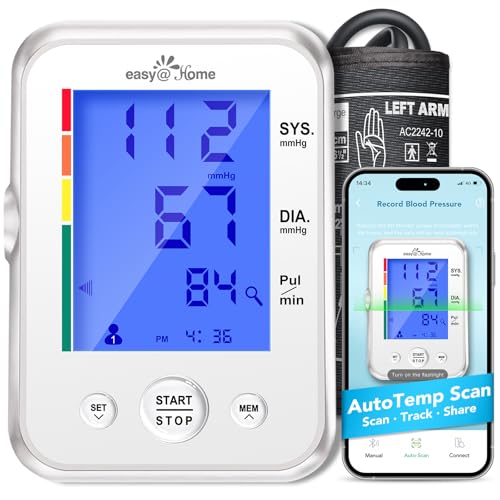
The easy-to-use upper arm BP monitor offers superior accuracy and the date-time setup makes tracking easy and efficient. There is only one button to operate the device that measures both pulse rate and blood pressure at the same time.
The device is compact and portable making it easy enough to carry in a small carrying bag that comes with the device. The user can easily examine their past readings to monitor the progress considering that the device offers up to 120 readings recorded in total and distributed between a set of two users. The device can intelligently average the past three measurements for the user.
The BP monitor also has an irregular heartbeat (arrhythmia) indicator that can alert the user of any abnormality. The monitor supports cuff sizes ranging from 8.67 to 16.5 inches.
Pros
- Two user modes and 120 total record measurement capacity
- Easy to use and set up
Cons
- Adapter not included
#4 Omron RS2 Wrist Blood Pressure Monitor HEM-6113-E
The Omron RS2 Blood Pressure Monitor is convenient and lightweight (weighing approximately 3.52 ounces). It is fully automatic and features a hypertension indicator along with an irregular heartbeat detector. The hypertension indicator lights up the moment the user’s blood pressure exceeds the recommended levels. Both these features make it easier to check for high blood pressure in the user.
No products found.This unit has 30 storage memories and comes with a 3-year guarantee. It also has an easy-to-read monitor with large and clear digits. The har plastic case makes it ideal for carrying around unobtrusive in a bag.
Pros
- Easy to put on or off
- Easy to carry around
Cons
- Adapter not included
- Readings can fluctuate sometimes because the wrist is naturally not at the heart level
No products found.
You may also like Best Medical Alert System Without Landline
#5 Omron Evolve Bluetooth Upper Arm Blood Pressure Monitor
The Omron Evolve Bluetooth Upper Arm Blood Pressure Monitor eliminates the tubes and wires from a regular Blood pressure Monitor and becomes one of the most compact, portable, and 1-piece designs.
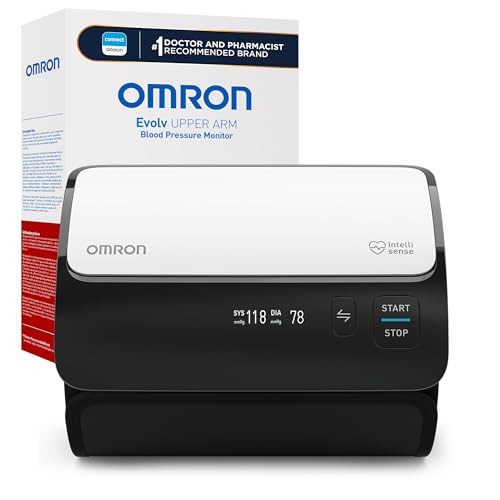
It can store unlimited BP readings with the usage of the Omron Connect App. The Bluetooth-enabled monitor uses advanced accuracy to provide precise results, that can be easily transmitted to the smart devices while tracking your measurements on a daily basis. It can track a history of your readings along with irregular heartbeat, diastolic, systolic, and pulse-related data.
The design is not only sleek but also contemporary. The controls are highly intuitive and make it easy to set up and use both. It has a pre-formed cuff that can comfortably wrap around the standard and larger arms catering to the circumference of 9 inches to 17 inches.
The Omron Connect App offers a free online dashboard that lets you track and manage the health of your heart. This app can be easily downloaded from App Store (Apple) and Play Store (Android).
The app allows wirelessly syncing of an unlimited number of readings to the smartphone. You can store and track your data on your mobile devices using Bluetooth technology. You can even email the data to your family or your health practitioner.
Omron Evolv is clinically validated and claims to offer better accuracy compared to other monitors through its assessment of more data points, which allows it to eliminate routine interference that is commonly observed due to incidental arm movements.
Pros
- Omron App’s Bluetooth support helps in noting blood pressure fluctuations, without manually writing them down
- Small, compact, easy to store and carry around
- The app allows multiple users to track their readings. It is also compatible with Amazon’s Alexa
- Cuff offers a comfortable fit and is easy to put on and off
Cons
- The blood pressure cuff could not hold more than one reading although this can happen with the app. This means that the other family members can simultaneously track their readings only on their smartphones.
#6 HealthSmart Digital Blood Pressure Monitor
The HealthSmart Standard Series Automatic Wrist Digital Blood Pressure Monitor is stylish and compact and helps you in keeping track of your blood pressure with ease and convenience.

You can easily read the results on the digital LCD screen that displays a calendar as well as a digital clock. The contemporary monitor measures 1.75 inches in height and 1.25 inches in width and connects to a sophisticated black-colored wrist cuff.
The monitor holds up to 120 blood pressure and heart rate readings for two users. This makes it simple and easy for you to spot patterns when you archive each reading by date and time. The last three readings are averaged so that you can track your progress.
The HealthSmart monitor also informs you in case it detects an irregular heartbeat. This makes it easy for the user to keep a check on signs of arrhythmia or palpitations.
The packaging includes a sleek carrying case along with the LCD monitor, a standard wrist cuff measuring 5.3″ – 8.5″ and 3 AAA batteries.
Pros
- Storage of up to 120 readings for 2 users
- Easy to carry around
- Comes with irregular heartbeat detection
Cons
- Battery Powered. You cannot use it with an adapter
- Readings can fluctuate sometimes because the wrist is naturally not at the heart level
You may also like Best Security Camera for Elderly
#7 Omron Complete Wireless Blood Pressure Monitor + EKG
The Omron Complete Wireless Blood Pressure Monitor is a 2-in-1 device with wide D-ring cuffs that fit arms with 9 to 17 inches in circumference.
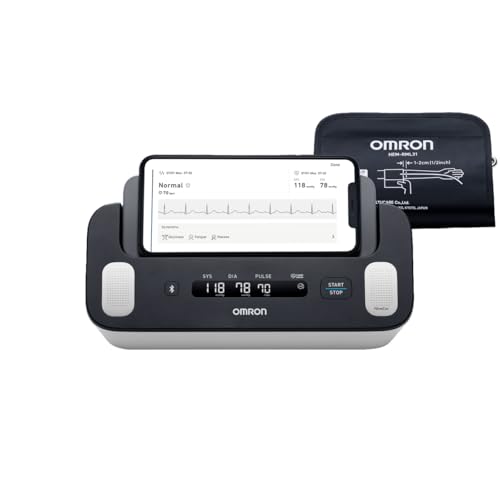
The comprehensive data measures EKG and blood pressure simultaneously. This also includes diastolic and systolic, pulse, tachycardia, bradycardia, atrial fibrillation, and sinus rhythm.
You probably might not require your EKG results unless your cardiologist requests the readings and recommends doing testing at home. But if they ask for this, getting your EKG from this device is as simple as getting your blood pressure taken.
Traditionally, getting EKG readings requires attaching electrodes. But in order to get the readings from this device, you need to just touch your thumbs to a pair of sensors. the results can be seen right on your smartphone, saved as well as shared.
The user can also connect to the free Omron app using Bluetooth technology, where you can store and track unlimited readings, and share results with your health practitioner. The app works with both iOS and Android devices.
This device also offers essential insights related to your heart’s health. This can help your doctor or cardiologist to take informed cardiac treatment decisions.
It is worth noting that when you perform an EKG for the very first time, you cannot see it until the EKG is automatically uploaded and analyzed by a board-certified cardiologist. Once you get your report on the EKG (typically in a day or so), you can perform additional EKGs to see your results right away.
Do remember to always place your smart device on the smartphone stand on your monitor to get the most accurate reading.
Pros
- Ability to measure your blood pressure and EKG simultaneously
- unlimited memory storage available in the app
- Smart Voice Integration with Amazon’s Alexa
Cons
- Battery Powered. The device is not compatible with AC Adapter
#8 iHealth Track Wireless Blood Pressure Monitor Upper Arm
The iHealth Track wireless Blood Pressure Monitor Upper Arm does not require any calibration and is clinically accurate. It has a large backlit multi-color display.
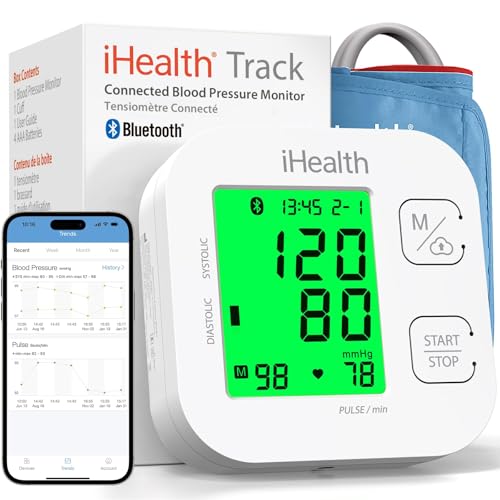
The oversized large numbers on its display make it easy to read results from the device. It color-codes your readings as red, yellow, or green to identify whether your results are fine or a potential cause for additional attention.
A user can manage 99 readings in total on the device and readings on their smartphone are unlimited connected to iHealth’s free Android and iOS applications.
The device also identifies automatically and alerts the user to any disturbance in heart rhythm. This alert is conveyed through a warning that is displayed once the device takes the measurement. This feature is not commonly available in many blood pressure monitors and definitely not the ones in this price range.
It supports a wide cuff size with a diameter 8.7 inches to 16.5 inches.
Pros
- The color-coded backlit display indicates different blood pressure levels indicating instances that need urgent attention
- You can set up reminders to measure your blood pressure
- You can export your readings as CSV, XLS, or PDF to share with your health practitioner
- One button measurement
Cons
- No option to average the last three readings
- Battery operated; No Adapter usage
You may also like Best Fitness Watch for Wheelchair Users
#9 Withings BPM Connect – Smart Blood Pressure Monitor
The Withings Wi-Fi BPM offers heart rate and blood pressure measurements which are medically accurate that offer feedback immediately. The feedback is delivered in the device itself while providing full history of data in app.
No products found.It is one of those smart monitors that do not have hoses or cables attached to the display. It is durable and portable thanks to its compact and easy-to-carry design.
The device assists you in monitoring the diastolic and systolic blood pressure along with your heart rate. It provides instant feedback which is color-coded for hypertension making it easy to read and understand.
The device is compact in design and is made using high quality materials making it very portable. You also do not need to worry about batteries as this device is recharged using a micro-USB. One charge lasts for 6 months for this device.
Wi-Fi synchronization ensures that the readings data is automatically synced to your smartphone via your home Wi-Fi network. This means that you do not need your smartphone near you every time you are taking the readings. You can find the full history of your readings in the Health Mate app using Bluetooth or Wi-Fi or synchronization.
You can also check on BPM Connect to check for the effectiveness of the treatment or merely for prevention. You just need to tap few times on the smartphone to share your readings with your health practitioner. The Share is however currently available only on iOS.
Pros
- No need for batteries. Rechargeable via micro USB that comes with the device
- One charge lasts up to 6 months
- Easy to read and understand with the feedback which is color coded on the LED display
Cons
- Works only with the app Health Mate as of now
- Email of reports to healthcare provider from the app only available on iOS
No products found.
#10 QardioArm Wireless Blood Pressure Monitor
The QardioArm Wireless Blood Pressure Monitor connects to your smartphone via its free app. It works well with Apple Watch or Android Wear.
No products found.Its stylish design combined with lightness and portability makes it a good buy. The one-piece wide-range cuff is comfortable and fits the standard to large adult upper arms ranging from 8.7 to 14.6 inches in circumference.
The battery life for this device lasts up to a year of frequent usage. It can store, monitor, and track your progress in the app and can also allow for on-demand sharing of your data with your family or health practitioner via app or emails.
The device can be paired with up to eight smartphones or tablets simultaneously. Each time you use this device, QardioArm will automatically average three readings and store all your measurements and notes in the Qardio HIPAA-compliant cloud.
It offers advanced features like measurement charts, multi-user reminders, notes addition, and irregular heartbeat detection. The data from this device can be synced with Apple Health, Samsung Health or Android Devices.
Pros
- Easy data sharing option through the app or email
- Easy integration with Apple Health and Samsung Health
- Stylish, Lightweight, and Portable
Cons
- Cheaper options are available if you need a basic blood pressure monitoring device
No products found.
You may also like Best First Aid Kit for Seniors
Conclusion
Being able to monitor the blood pressure of the elderly at home itself is really helpful. It is generally recommended that families get a home BP monitor if possible and learn how to use it.
When choosing a home blood pressure monitor, look for a well-reviewed digital machine with a properly sized arm cuff and get the accuracy of the machine checked at your doctor’s clinic. By the way, we wrote a separate article on other monitoring devices for the elderly including a pulse oximeter, thermometer, activity tracker, and camera.
Additional features like Bluetooth or Wireless Synchronization, EKG measurements, color-coded displays, etc. are features that are good to have. Moreover, not every user will require these features and can even do with regular priced basic devices that are showcased in this article.

